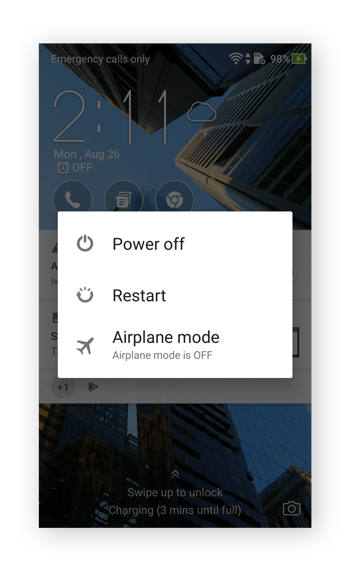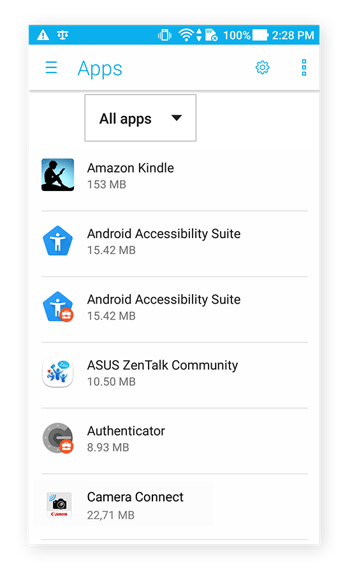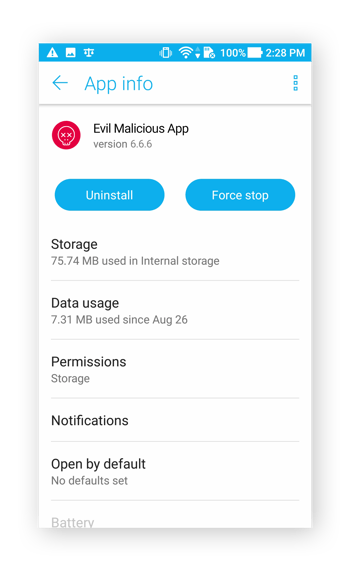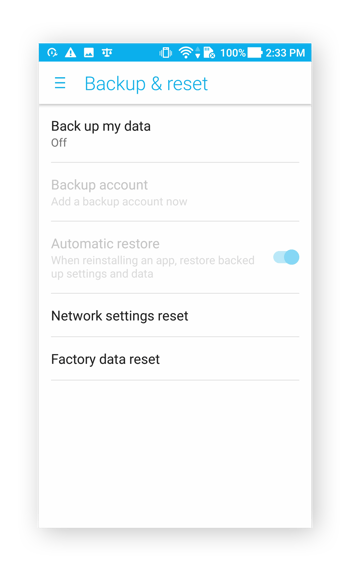How To Repair Goole From Virus In Andriod Phone
Here's how to run an antivirus scan to remove a virus from your Android automatically:
Option one: Automatically remove the malware
Install Avast One for Android, a free app that apace scans your device to run into if a virus is present. If an infection is found, y'all'll be prompted to remove the virus rapidly and easily.
Step 1: Run your antivirus scan
Near mobile antivirus programs are straightforward to employ. But tap the "scan" push button and allow the app get to piece of work.
Step two: Resolve identified issues
Once you've completed your scan, follow the prompts within the user interface to clear up any risks that may have been uncovered.
Option 2: Manually remove the malware
If you aren't using an Android mobile security app, or if your chosen anti-malware app couldn't resolve the outcome, there are other methods. Hither's how to remove the malware from your Android phone manually:
Step 1: Put your phone into Safe Mode
Restarting your phone in safety mode prevents all third-political party apps from running, including malware. Some Android phones will let y'all reboot in safety style, while others need a few extra steps to get there.
On many devices, you can access safe mode past holding down the power button equally though you lot were planning to turn your phone off. Long-printing the Ability off option for a second or two.
Long-printing the Ability off option for a second or two.
Tap OK when asked if you'd like to reboot into rubber mode.
Once you've entered safe mode, assess whether or non the issues are still nowadays. If not, it's likely that they were acquired by malware in a third-party app.
Step 2: View your downloaded apps
In one case yous're in Safe Mode, go to Settings > Apps. Look for any apps that seem suspicious — maybe an app that y'all're non very familiar with, or i you don't recollect installing yourself. The all-time identify to start is with the apps that were installed immediately earlier your phone began acting strangely.
Step 3: Uninstall recent downloads
One time you've identified a potentially troublesome app, tap Uninstall to delete it for good. In the result that you've guessed incorrectly, you tin can always reinstall it later. In a last-ditch effort for survival, many virus-ridden apps will disable the Uninstall push button, in which case you'll want to remove their administrative privileges.
Step 4: Forbid these apps from beingness device administrators
Navigate through your security settings to find a list of apps with device administrator permissions. Depending on your Android version or phone manufacturer, your path may look something similar this: Settings > Security > Device Administrators.
Once there, come across if the troublemaker app is featured on the list. If y'all see it, take a look at the little box to the right of its name, and note whether or not it'southward checked.
If it is, uncheck the box, then select Deactivate this device ambassador to remove its access privileges. At present, return to the app in Downloaded Apps. The Uninstall button should exist tappable at present, so go alee and send that app packing.
Every bit a final step, head to your Downloads folder and delete the malware's .apk installation file, if you encounter information technology.
Restart your phone in normal operations style, and confirm that you've resolved your symptoms. If so, congrats: you lot've mastered how to remove a virus from your Android telephone. If not, you may need to echo this process, this time uninstalling a unlike app, or consider a full factory reset.
Remember that performing a factory reset deletes all apps and app data from your phone, and then it'due south always a good idea to set periodic information backups.
Option 3: Reset your Android phone
If both the above methods fail to resolve your issue, you can reset your telephone back to its original factory settings. Here'southward how to factory reset your Android phone to get rid of whatever malware:
Step one: Perform a Factory Information Reset
Navigate to Settings > Fill-in & Reset> Mill Data Reset. 
At present tap Reset device. 
Step 2: Enter your passcode when requested
Enter your passcode to go on, then tap Erase everything. In the screenshot below, the user is asked to enter a generic access code, considering in that location is no password enabled on this instance device (you should ever password-protect your personal mobile, though!).
Step iii: Reboot your device
After the factory reset is complete, your telephone will restart and take you through its initial setup procedures.
Footstep 4: Restore from a previous fill-in
Eventually, y'all'll be asked whether you'd like to restore your phone from a backup, or get-go over. Here, you lot can elect to restore your phone from a backup that dates dorsum to before y'all'd installed the malicious app.
Can Android phones get viruses?
Android phones can go various types of malware, just they're unlikely to go a traditional computer virus. A virus gets into files on your operating organization and uses your device's resources to replicate and spread. Malware on your Android phone likely won't behave in this mode. To learn more about mobile malware, check out our dedicated article about viruses and other malware on phones.
Rather, Android malware usually comes in the class of malicious apps that tin can steal your data, spy on you, harm your device, or cause other bug. Viruses are one type of malware that doesn't usually impact Android, but many people apply the term "Android virus" anyway to refer to any kind of Android malware.
And so if you lot're wondering how to remove viruses from your Android phone, keep in mind that you're dealing with a unlike type of malicious software.
The kickoff phone malware
Before smartphones became the ubiquitous companions they are today, the prison cell phone viruses was considered somewhat of a myth. Computers could get viruses, merely smartphones were immune," went the prevailing wisdom of the day. This illusion of safety was shattered in 2004 after hacker grouping 29A created the Cabir mobile telephone worm and sent information technology as a proof of concept to several professional cybersecurity labs.
When installed, Cabir — a network worm — would display the word "Caribe" on the screen of infected devices while seeking to infect others via active Bluetooth connections. As a proof of concept, Cabir didn't cause any direct damage, but the message was articulate: phones can get malware likewise.
In Cabir's wake, numerous malicious actors took advantage of the new opportunities for mayhem and personal proceeds, creating their own malware with serious potential for harm. Some of these include:
-
SymOS/Kiazha.A: a ransomware Trojan that targeted Symbian Os and deleted incoming and outgoing SMS messages.
-
CommWarrior: a worm that resets the telephone on the 14th of every calendar month. Skull imagery installs equally a theme bundle, but the file goes on to disable programs and applications. It besides turns all the icons on the telephone into Jolly Roger or jigsaw images.
Many malware threats have emerged since smartphones have grown in popularity, and more keep to surface every day. Cybercriminals are constantly innovating new methods to trick users into installing their malware. Take an active role in your digital security by learning more than near how these threats work, and what you can do to protect against them.
Types of phone malware
Android malware comes in many varieties, each with its own quirks and preferred entry vectors. Here are some of the most mutual types of Android malware:
Spyware
This type of malware is designed to stealthily glean information from your telephone and transmit information technology back to the hacker. Cybercriminals disguise their spyware as legit applications, which is how they endeavour to trick y'all into installing it. Once installed, the spyware records information including SMS/text messages, URLs browsed, app activeness, keyboard inputs, usernames, and passwords.
Ransomware
As the name implies, ransomware blocks access to your device or your data, holding it hostage in exchange for a hefty fee. Though the temptation to liberate your device and files is understandable, yous should never pay a ransomware cybercriminal. Instead, attempt and remove the ransomware from your Android device and then restore an earlier backup.
Worms
Worms are the most aggressive blazon of Android malware. Designed to endlessly replicate and spread, worms are democratic and can operate without any user interaction. They more often than not arrive via SMS, MMS, or other digital media.
Trojans
Trojans act as legitimate applications and infect your phone once the app has been installed. Unlike worms, Trojans need a user to install them earlier they can carry out their deportment. Once activated, Trojans can install boosted malware, deactivate other applications, record your personal data, or lock upward your phone for a sure menses of time.
Specific examples of Android malware
Avast Threat Labs has discovered many strains of Android malware. Our researchers piece of work tirelessly to detect these malicious apps and go them removed from the Google Play Store as soon as possible to prevent their spread.
-
In 2022, Avast researchers uncovered a group of malicious apps in the Google Play Store that sent premium text messages to rack up huge charges. Nosotros alerted Google and they removed the malicious apps.
-
In 2022, Avast Threat Labs discovered pre-installed adware on brand new Android devices. We detected this malware on about 18,000 devices in more than 100 countries, and pushed Google to mitigate the app's malicious capabilities.
-
In 2022, a new family of Android ransomware was establish. This Filecoder ransomware started spreading through posts on cyberspace forums like Reddit, and continued by spreading to all contacts in an infected telephone. Once on an Android, the ransomware encrypts most files on the device and demands a bribe of $200.
-
In 2022, Avast tracked downwardly Android adware spreading through TikTok. Interesting fact: a 12-year-old girl helped uncover the scam when she sent a report to Avast!
-
In 2022, Avast researchers discovered another 21 malicious apps on Google Play. The apps were mainly masquerading as gaming apps, but they actually contained adware.
-
That same yr, Avast Threat Labs also discovered a banking Trojan hiding on Google Play. Downloaded more than 10,000 times, the malicious app posed every bit a currency converter app and targeted Android users in Espana until Avast reported information technology to Google and they removed information technology.
Those are just a few examples of the hundreds or even thousands of malicious Android apps out in that location. Another known Android virus strains are (listed alphabetically): Agent Smith virus, Android ads on Lock Screen, Android ransomware, Android Police virus, Anubiscrypt ransomware, Com.google.provision, Com.android.system.ui, Com.android.gesture.architect, DoubleLocker ransomware virus, Imitation virus warning Android, Funnwebs.com, GhostCtrl virus, Ghost Push virus, Gooligan malware, HummingBad virus, HummingWhale virus, Invisible Human, JavaTcmdHelper virus, Lastacloud virus, LeakerLocker ransomware virus, Lockdroid ransomware, LokiBot virus, Mazar malware, NotCompatible virus, Opt Out virus, Smart cars-hacking Android malware, Svpeng virus, Tizi Android virus, and more.
Android vs. iPhone infections
Androids and iPhones have different and distinct vulnerabilities to malware. While iOS was long considered allowed to malware, recent attacks have proved that iPhones are vulnerable to security threats.
Android users are more likely than their iOS counterparts to contract malware simply because at that place are multiple places for them to notice Android apps (Android phones make up most 90% of the global market share for smartphones). Some of these portals are secure, just others are non.
iOS users by and large download apps from Apple'south official App Shop, which uses some of the nearly robust security measures in existence. Apps on iOS cell phones and tablets are sandboxed, which means that their ability to interact with other applications or with iOS itself is limited. Android apps are also sandboxed, but to a bottom extent.Powering devices made by Samsung, Huawei, and Google itself, Android reigns as the globe'due south most pop mobile phone operating system. This massive user base means that information technology struggles with updating all of its users to the latest secure version of its operating system. This affords hackers more time to hone their methods and attack more Android users.
Where Android malware comes from
When you familiarize yourself with where Android malware commonly comes from, you lot're one step closer to keeping it off your mobile device.
Infected applications
Hackers repackage popular apps with malware, then distribute the poisoned versions through various app stores and download portals. This technique is so successful, cybercriminals will oft create make-new apps specifically to trick users into installing them. The user believes that they've plant an exciting new app, simply instead, they're getting an Android malware download.
Malvertisements
Malvertising is the practice of inserting malware in ads that are distributed through advertizement networks. Clicking on 1 of these ads tin trigger a virus download to your device. Also be on the lookout for virus popular-ups on Android devices, every bit many of these ads may appear in pop-up windows. If you're looking to block pop-ups, check out our article on the all-time pop-up blocker apps for Android devices.
Scams
Online scams include phishing attacks and other popular email or SMS-based methods. Yous'll be sent a link, but when you click it, the website triggers a malware download to your device. This is one of the most mutual scams to get an infection on your Android phone.
Direct-to-device downloads
Directly-to-device infections require the hacker to attach a targeted device to another, and manually install the malware to it. This is the stuff of high-profile corporate espionage. Never plug your phone into an untrusted computer, and never connect unknown accessories to your devices.
How tin can you tell if your phone has malware?
It's not always like shooting fish in a barrel to recognize the signs, just you can learn how to find malware on your Android phone. Assuming you've been following along until now, y'all're already an expert on how to check your phone for malware: you tin can perform a scan with your preferred mobile security app, or investigate recently downloaded apps while in safe mode.Now that yous know what to exercise when you find one, hither are some of the more reliable symptoms that might become you asking: Does my telephone have a virus?
Apps that crash...a lot
Some apps tend to crash from time to fourth dimension, and equally you use them, you'll get a feel for what constitutes normal behavior for a particular app. If you find multiple apps crashing more than frequently than they should, you might be dealing with Android malware.
Unexplained increases in data usage
It's one affair to find that you're short on data afterwards, say, unblocking websites and binge-watching the latest season of your favorite evidence. Simply if the same thing happens while your telephone is hanging out in your pocket all day, you lot could accept reason to worry. Some malware volition chew through your mobile data as it operates, so information technology's a adept idea to check in on your data allotment from time to time.
Ads keep popping up
Yous can block annoying popular-upwardly ads with certain mobile browsers or browser extensions. If yous start seeing pop-ups even when you aren't running any apps, it's likely that you've got an adware infection on your easily.
Bombardment drains in no time at all
Since virtually mobile malware isn't optimized, it tends to drain your battery faster than other legitimate apps.
Your telephone bill is through the roof
Similar to a sudden bump in data usage, an unexpected and unexplainable increment on your phone bill is a perfect Android malware warning. It's always helpful to talk over unusually high billing amounts with your mobile service provider.
Unfamiliar apps
Many people don't have the time to check whether or not that trendy new app has been created by a legitimate programmer, especially when information technology comes to the massive range of free-to-play games out there. This oversight can prove plush, as you might inadvertently requite a false app the keys to your telephone kingdom.
Phone starts overheating
In that location are plenty of reasons for why your phone might overheat, but a malware infection is one of the near mutual causes. If you aren't doing anything abnormal with your phone, it shouldn't be hot to the touch.
Tips for running antivirus on Android
What exactly makes an antivirus app trustworthy? What makes one antivirus app better than some other? Other than Android malware scans, which additional features are worth paying for?
First with the source
Download your called antivirus app from Google Play. If downloading from the manufacturer, the link you tap should bring you to Google Play, from which you lot'll download the app.
The beingness of malware-laden security apps is an unfortunate reality. On multiple occasions, hackers have used both faux pages and social media to promote malware bearded as antivirus apps. This makes it disquisitional to…
Do your homework
Even amid trusted antivirus software, yous'll find a multitude of options claiming to be the best. Many of them volition advertise a free version to get you lot started.
To thin the herd, spend some time with third-political party labs like AV-TEST and AV-Comparatives. These organizations independently exam antivirus apps and publicly post the results to help consumers make informed decisions nigh which product to try.
Avast consistently ranks as one of the top-rated mobile antivirus providers. And Avast I received PCMag's Editors' Choice antivirus award and was given five stars from TechRadar.
Cull betwixt a paid and free version
In most circumstances, a reputable antivirus programmer's free version volition suffice. Avast Mobile Security for Android, for example, will protect against viruses, malware, and spyware. It volition also browse apps to sniff out Trojans and other infections. Every bit a full general dominion, you lot shouldn't have to pay a premium to be protected against cyberthreats. Here's a helpful guide on the best free antivirus software out there.
Avast'southward free antivirus app will help you lot optimize and clean up your Android phone, also. It comes with additional features including RAM optimization, anti-theft (which includes the ability to locate and remotely lock a lost or stolen phone), junk-file removal, download and upload speed checks, and real-fourth dimension protection while browsing the web.
The benefits of purchasing a paid version vary between developers. Premium functions might include Pivot or fingerprint access to chosen sensitive applications, or VPN services that safeguard your device while continued to public Wi-Fi. If yous're merely interested in how to check for malware on Android, your utilize of these additional features may vary, though college levels of mobile security are never a bad affair.
For the majority of mobile users, a robust, gratuitous antivirus app should do the pull a fast one on. Go with one that automatically updates its virus definitions to remain protected against the latest threats.
Keep your Android device protected
Without neglect, the single most impactful change you can make to better your mobile security habits is to install a proven mobile antivirus tool. Later all, you'll never demand to worry about removing malware if it can't get onto your phone in the first place.
Protect your Android confronting viruses, malware, and other threats with the free Avast I. Stay protected online with comprehensive, adaptive security that detects and blocks viruses and malware before they can infect your device. Plus, y'all'll get free VPN access, data leak protection, so much more.
Source: https://www.avast.com/c-how-to-remove-virus-from-android
Posted by: stoltejoyagoint.blogspot.com


0 Response to "How To Repair Goole From Virus In Andriod Phone"
Post a Comment